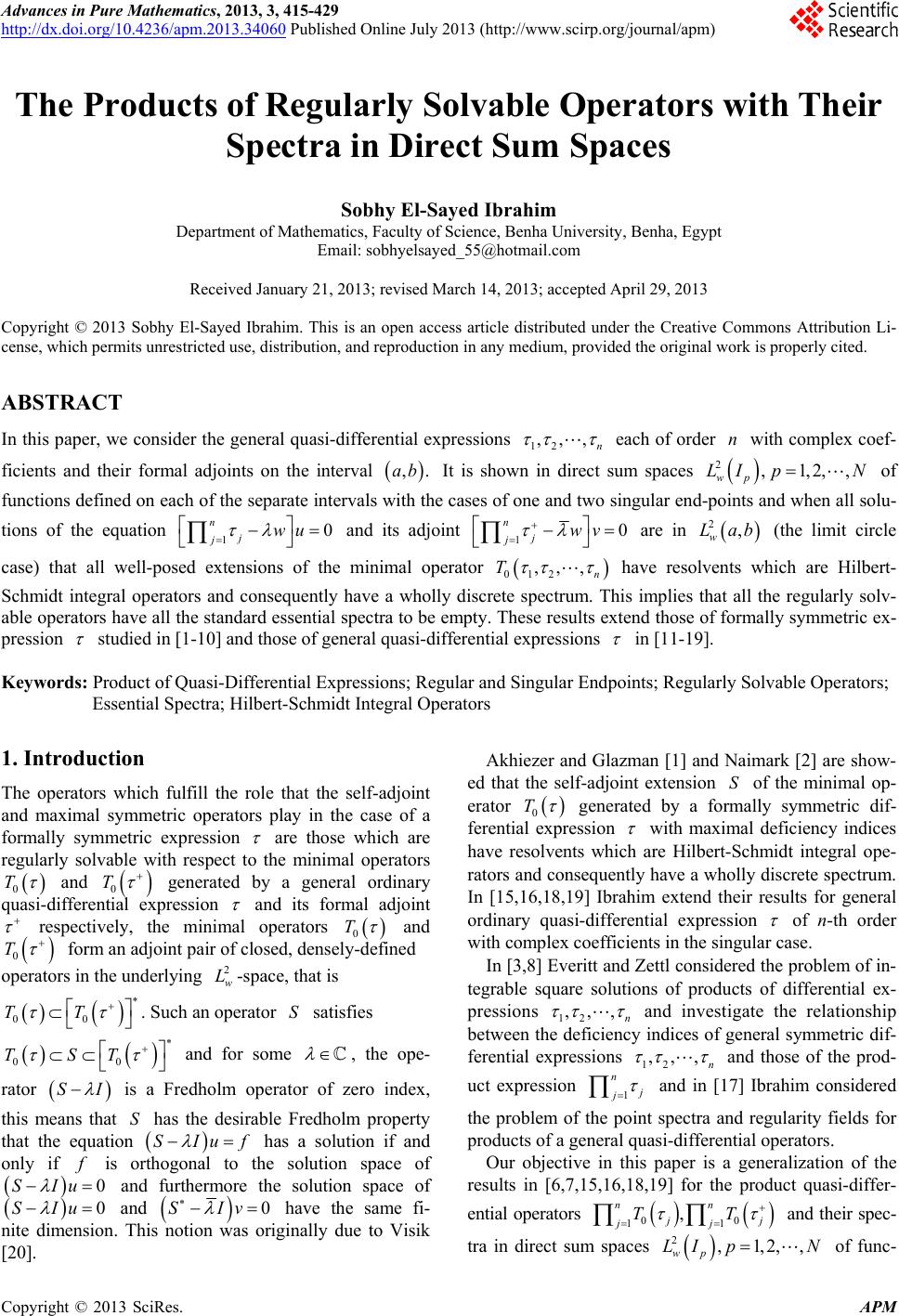 Advances in Pure Mathematics, 2013, 3, 415-429 http://dx.doi.org/10.4236/apm.2013.34060 Published Online July 2013 (http://www.scirp.org/journal/apm) Copyright © 2013 SciRes. APM The Products of Regularly Solvable Operators with Their Spectra in Direct Sum Spaces Sobhy El-Sayed Ibrahim Department of Mathematics, Faculty of Science, Benha University, Benha, Egypt Email: sobhyelsayed_55@hotmail.com Received January 21, 2013; revised March 14, 2013; accepted April 29, 2013 Copyright © 2013 Sobhy El-Sayed Ibrahim. This is an open access article distributed under the Creative Commons Attribution Li- cense, which permits unrestricted use, distribution, and reproduction in any medium, provided the original work is properly cited. ABSTRACT In this paper, we consider the general quasi-differential expressions 12 ,,, n each of order n with complex coef- ficients and their formal adjoints on the interval ,.ab It is shown in direct sum spaces 2,1,2,, wp LI pN of functions defined on each of the separate intervals with the cases of one and two singular end-points and when all solu- tions of the equation 10 n j jwu and its adjoint 10 n j jwv are in 2, w Lab (the limit circle case) that all well-posed extensions of the minimal operator 012 ,,, n T have resolvents which are Hilbert- Schmidt integral operators and consequently have a wholly discrete spectrum. This implies that all the regularly solv- able operators have all the standard essential spectra to be empty. These results extend those of formally symmetric ex- pression studied in [1-10] and those of general quasi-differential expressions in [11-19]. Keywords: Product of Quasi-Differential Expressions; Regular and Singular Endpoints; Regularly Solvable Operators; Essential Spectra; Hilbert-Schmidt Integral Operators 1. Introduction The operators which fulfill the role that the self-adjoint and maximal symmetric operators play in the case of a formally symmetric expression are those which are regularly solvable with respect to the minimal operators 0 T and 0 T generated by a general ordinary quasi-differential expression and its formal adjoint respectively, the minimal operators 0 T and 0 T form an adjoint pair of closed, densely-defined operators in the underlying 2 w L-space, that is 00 TT . Such an operator S satisfies 00 TST and for some , the ope- rator SI is a Fredholm operator of zero index, this means that S has the desirable Fredholm property that the equation SIuf has a solution if and only if is orthogonal to the solution space of 0SIu and furthermore the solution space of 0SIu and 0SIv have the same fi- nite dimension. This notion was originally due to Visik [20]. Akhiezer and Glazman [1] and Naimark [2] are show- ed that the self-adjoint extension S of the minimal op- erator 0 T generated by a formally symmetric dif- ferential expression with maximal deficiency indices have resolvents which are Hilbert-Schmidt integral ope- rators and consequently have a wholly discrete spectrum. In [15,16,18,19] Ibrahim extend their results for general ordinary quasi-differential expression of n-th order with complex coefficients in the singular case. In [3,8] Everitt and Zettl considered the problem of in- tegrable square solutions of products of differential ex- pressions 12 ,,, n and investigate the relationship between the deficiency indices of general symmetric dif- ferential expressions 12 ,,, n and those of the prod- uct expression 1 n j and in [17] Ibrahim considered the problem of the point spectra and regularity fields for products of a general quasi-differential operators. Our objective in this paper is a generalization of the results in [6,7,15,16,18,19] for the product quasi-differ- ential operators 00 11 , nn j jj TT and their spec- tra in direct sum spaces 2,1,2,, wp LI pN of func- 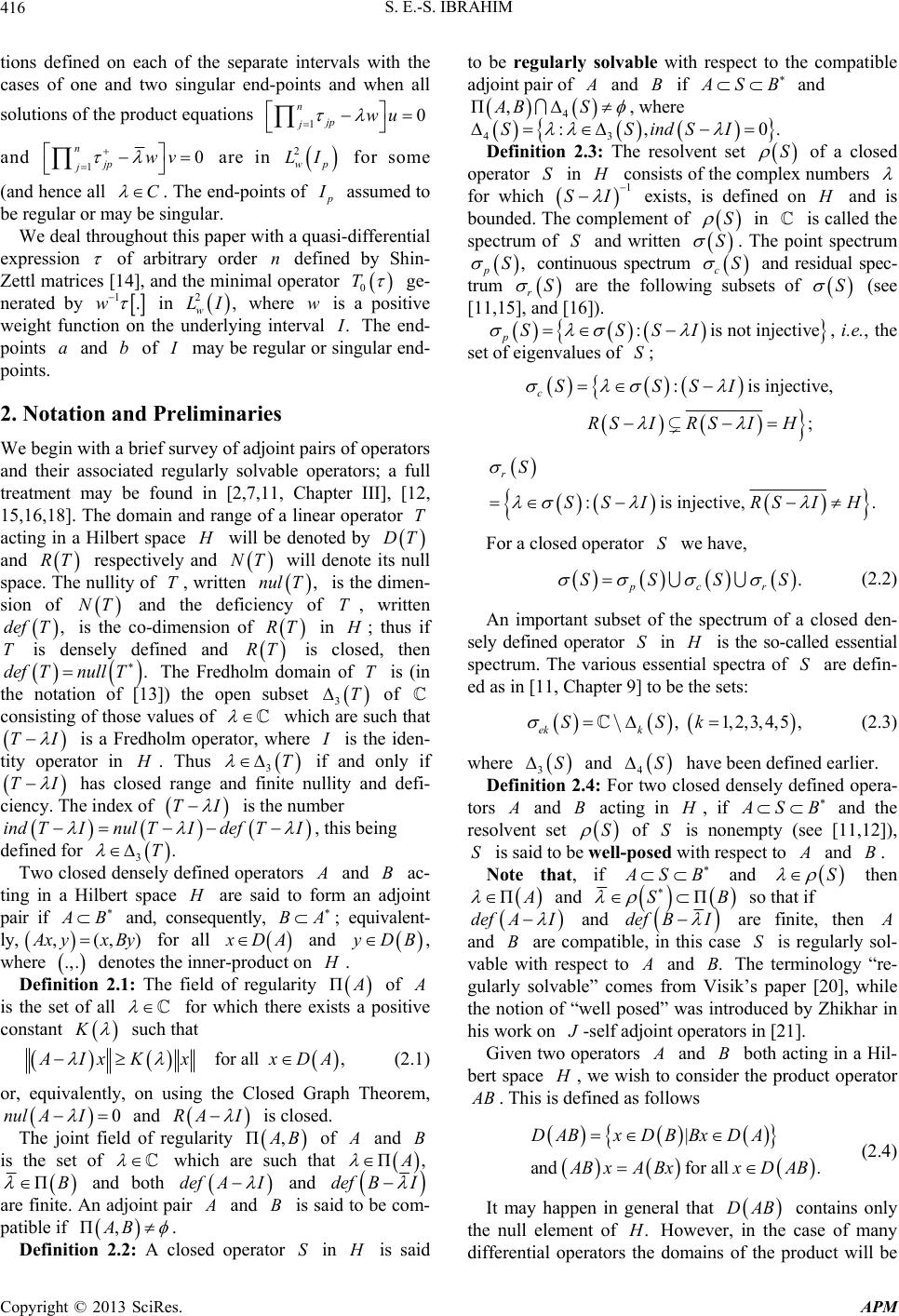 S. E.-S. IBRAHIM Copyright © 2013 SciRes. APM 416 tions defined on each of the separate intervals with the cases of one and two singular end-points and when all solutions of the product equations 10 n jp jwu and 10 n jp jwv are in 2 wp LI for some (and hence all C . The end-points of p assumed to be regular or may be singular. We deal throughout this paper with a quasi-differential expression of arbitrary order n defined by Shin- Zettl matrices [14], and the minimal operator 0 T ge- nerated by 1.w in 2, w LI where w is a positive weight function on the underlying interval . The end- points a and b of may be regular or singular end- points. 2. Notation and Preliminaries We begin with a brief survey of adjoint pairs of operators and their associated regularly solvable operators; a full treatment may be found in [2,7,11, Chapter III], [12, 15,16,18]. The domain and range of a linear operator T acting in a Hilbert space H will be denoted by DT and RT respectively and NT will denote its null space. The nullity of T, written ,nul T is the dimen- sion of NT and the deficiency of T, written ,def T is the co-dimension of RT in H; thus if T is densely defined and RT is closed, then .defTnull T The Fredholm domain of T is (in the notation of [13]) the open subset 3T of consisting of those values of which are such that TI is a Fredholm operator, where is the iden- tity operator in H. Thus 3T if and only if TI has closed range and finite nullity and defi- ciency. The index of TI is the number indT InulTIdefT I , this being defined for 3.T Two closed densely defined operators A and ac- ting in a Hilbert space H are said to form an adjoint pair if B and, consequently, BA ; equivalent- ly, ,(,) xy xBy for all DA and DB, where .,. denotes the inner-product on H. Definition 2.1: The field of regularity Π of A is the set of all for which there exists a positive constant K such that for a,ll IxKxx DA (2.1) or, equivalently, on using the Closed Graph Theorem, 0nul AI and RA I is closed. The joint field of regularity Π, B of and is the set of which are such that Π, ΠB and both def AI and def BI are finite. An adjoint pair and is said to be com- patible if Π,AB . Definition 2.2: A closed operator S in H is said to be regularly solvable with respect to the compatible adjoint pair of and if SB and 4 Π,AB S , where 43 :, 0.SSindSI Definition 2.3: The resolvent set S of a closed operator S in H consists of the complex numbers for which 1 SI exists, is defined on H and is bounded. The complement of S in is called the spectrum of S and written S . The point spectrum , pS continuous spectrum cS and residual spec- trum rS are the following subsets of S (see [11,15], and [16]). is not injev:ctie pSSSI , i.e., the set of eigenvalues of S; is injective,: ; cSSSI RS IRS IH is inject:iv .e, rS SSI RSIH For a closed operator S we have, . pcr SSSS (2.2) An important subset of the spectrum of a closed den- sely defined operator S in H is the so-called essential spectrum. The various essential spectra of S are defin- ed as in [11, Chapter 9] to be the sets: ,1,2,3,4,5, ek k SSk (2.3) where 3S and 4S have been defined earlier. Definition 2.4: For two closed densely defined opera- tors A and acting in H, if SB and the resolvent set S of S is nonempty (see [11,12]), S is said to be well-posed with respect to A and . Note that, if SB and S then Π and ΠSB so that if def AI and def BI are finite, then A and are compatible, in this case S is regularly sol- vable with respect to A and .B The terminology “re- gularly solvable” comes from Visik’s paper [20], while the notion of “well posed” was introduced by Zhikhar in his work on -self adjoint operators in [21]. Given two operators A and both acting in a Hil- bert space H, we wish to consider the product operator AB . This is defined as follows | andfor all . DABx DBBxDA BxABxx DAB (2.4) It may happen in general that DAB contains only the null element of .H However, in the case of many differential operators the domains of the product will be  S. E.-S. IBRAHIM Copyright © 2013 SciRes. APM 417 dense in H. The next result gives conditions under which the defi- ciency of a product is the sum of the deficiencies of the factors. It is a generalization of that in [3, Theorem A] and [8]. Lemma 2.5 (cf. [17, Lemma 2.3]). Let and be closed operators with dense domains in a Hilbert space H. Suppose that Π,. B Then B is a closed operator with dense domain and .def ABIdefAIdefBI (2.5) Evidently Lemma 2.5 extends to the product of any fi- nite number of operators 12 ,,, n AA. 3. Quasi-Differential Expressions in Direct Sum Spaces The quasi-differential expressions are defined in terms of a Shin-Zettl matrix p F on an interval p . The set np I of Shin-Zettl matrices on p consists of nn-matrices ,1,2,, p prs fp N, whose entries are complex-valued functions on p which satisfy the following conditions: 2 ,1 ,1 ,,2 0,1 1a.e., on a.e.,0,,21,1, 2,n,.o p rsloc p p rr p p rs p fLIrsnn fIrn Irsnp N (3.1) For np ZI, the quasi-derivatives associated with p F are defined by: 0 111 ,1 1 11 1 :, :,11 :, r rrs pp rr rs s n nn n p rs s yy yf yfyrn yy fy , (3.2) where the prime ' denotes differentiation. The quasi-differential expression p associated with p F is given by: .:, 2, n n piy n (3.3) this being defined on the set: 1 :: ,1,2,,, 1, 2,, r plocp VyyACIr n pN where , loc p CI denotes the set of functions which are absolutely continuous on every compact subinterval of p . The formal adjoint of p is defined by the ma- trix given by: for all.: ,, n n pp iyy V (3.4) 1 :: ,1,2,,, 1, 2,, r plocp VyyACIrn pN where 1r y , the quasi-derivatives associated with the matrix in np I, 1 1,1 for eachan1d, rs pp prs nsnr ff rs . (3.5) Note that: p F and so p . We refer to [3,9] and [17-20] for a full account of the above and subsequent results on quasi-differential expressions. For uV , vV and ,p , we have Green’s formula, d ,,,1,2,,, p p b pp a pp vuuvx uv buv apN (3.6) where, 111 0 11 1 ,1 ,,, ; nrs rnr n r nnnn n uv xiuxvx v iuu uJx v (3.7) see [4,9] and [14-18]. Let the interval p have end- points p a, , ppp bab and let : pp wI be a non-negative weight function with 1 loc p wLI and 0 p w (for almost all p I). Then 2 p wp LI denotes the Hilbert function space of equivalence classes of Lebesgue measurable functions such that 2 pp Iwf ; the inner-product is defined by: 2 ,: d , . 1,2,,. p p p pI wp fgwfxgx x gLIpN (3.8) The equation 0on,1,2,,, pp p uwuIp N (3.9) is said to be regular at the left end-point p a , if for all , p ab, 1 ,,, , ,1,2, ,;1,2, ,. p pprs p awfLaX rs npN Otherwise (3.9) is said to be singular at p a. If (3.9) is regular at both end-points, then it is said to be regular; in this case we have, 1 ,,, ,, ,1,2, ,;1,2,,. p pp prspp abw fLab rsnpN 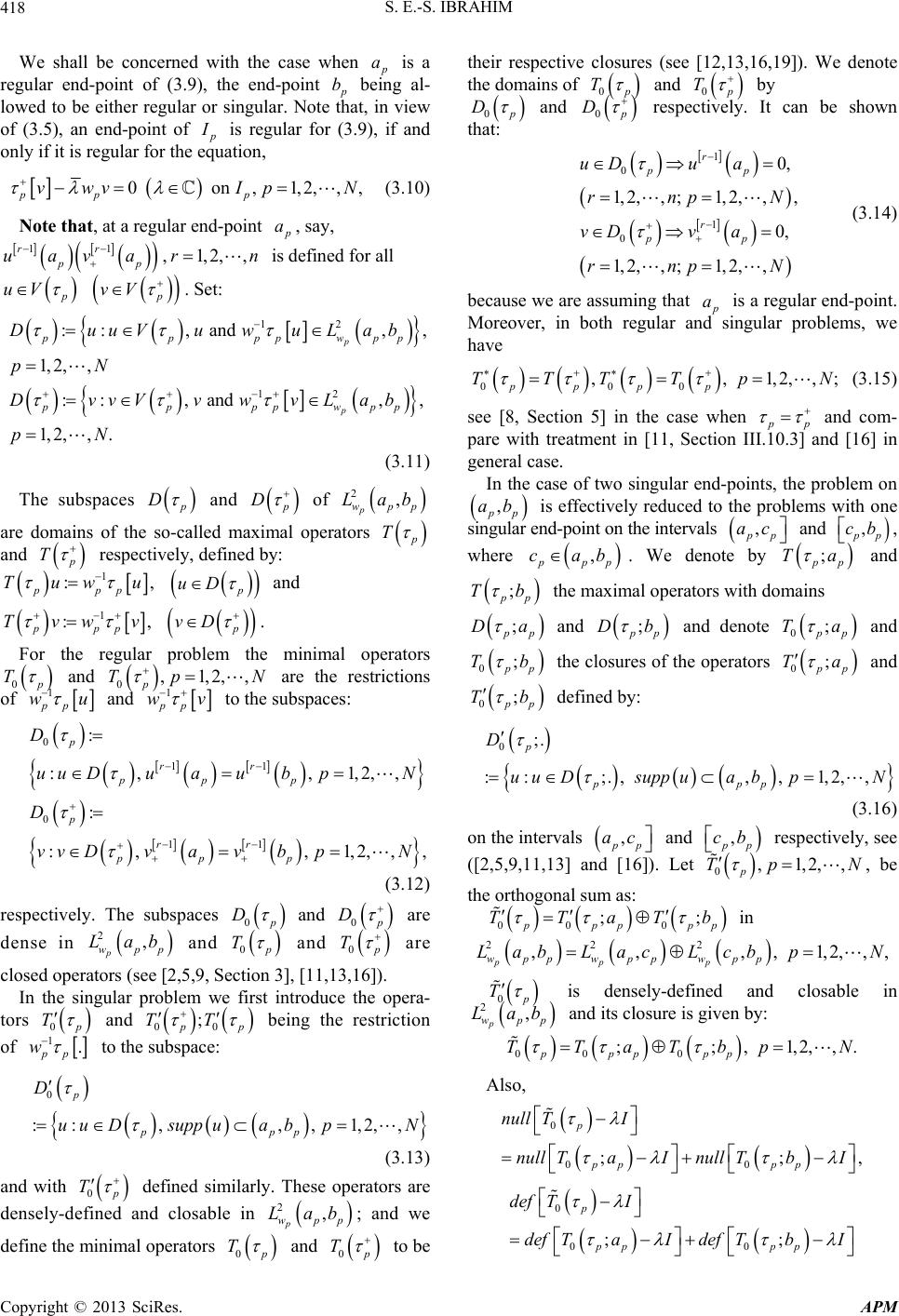 S. E.-S. IBRAHIM Copyright © 2013 SciRes. APM 418 We shall be concerned with the case when p a is a regular end-point of (3.9), the end-point p b being al- lowed to be either regular or singular. Note that, in view of (3.5), an end-point of p is regular for (3.9), if and only if it is regular for the equation, 0on,1,2,,, ppp vwvIp N (3.10) Note that, at a regular end-point p a, say, 11rr pp uava ,1, 2,,rn is defined for all uV p vV . Set: 12 12 ::, and,, 1, 2,, ::, and,, 1, 2,,. p p ppppwpp ppppwpp DuuVuwuLab pN DvvVvwvLab pN (3.11) The subspaces D and D of 2, p wpp ab are domains of the so-called maximal operators T and T respectively, defined by: 1 :, ppp Tuwu p uD and 1 :, ppp Tvwv p vD . For the regular problem the minimal operators 0 T and 0,1,2,, p Tp N are the restrictions of 1 pp wu and 1 pp wv to the subspaces: 0 11 0 11 : :, ,1,2,, : :, ,1,2,,, p rr pp p p rr pp p D uu DuaubpN D vv DvavbpN (3.12) respectively. The subspaces 0 D and 0 D are dense in 2, p wpp ab and 0 T and 0 T are closed operators (see [2,5,9, Section 3], [11,13,16]). In the singular problem we first introduce the opera- tors 0 T and 00 ; p TT being the restriction of 1. pp w to the subspace: 0 :: ,,,1,2,, p ppp D uuDsupp uabpN (3.13) and with 0 T defined similarly. These operators are densely-defined and closable in 2, p wpp ab ; and we define the minimal operators 0 T and 0 T to be their respective closures (see [12,13,16,19]). We denote the domains of 0 T and 0 T by 0 D and 0 D respectively. It can be shown that: 1 0 1 0 0, 1, 2,,;1,2,,, 0, 1, 2,,;1,2,, r pp r pp uDua rnp N vDva rnp N (3.14) because we are assuming that p a is a regular end-point. Moreover, in both regular and singular problems, we have 000 ,,1,2,,; pppp TTTTp N (3.15) see [8, Section 5] in the case when p and com- pare with treatment in [11, Section III.10.3] and [16] in general case. In the case of two singular end-points, the problem on , p ab is effectively reduced to the problems with one singular end-point on the intervals , p ac and , pp cb , where , pp cab. We denote by ; p Ta and ; p Tb the maximal operators with domains ; p Da and ; p Db and denote 0; p Ta and 0; p Tb the closures of the operators 0; p Ta and 0; p Tb defined by: 0;. :: ;.,,,1,2,, p ppp D uuDsuppua bpN (3.16) on the intervals , p ac and , p cb respectively, see ([2,5,9,11,13] and [16]). Let 0,1,2,, p Tp N , be the orthogonal sum as: 00 0 ;; pp pp TTaTb in 22 2 ,,,,1,2,,, ppp wpp wppwpp abL acL cbpN 0 T is densely-defined and closable in 2, p wpp ab and its closure is given by: 00 0 ;;,1,2,,. ppp pp TTaTbp N Also, 0 00 ;;, p pp pp null TI null TaInull TbI 0 00 ;; p pp pp def TI def TaIdef TbI 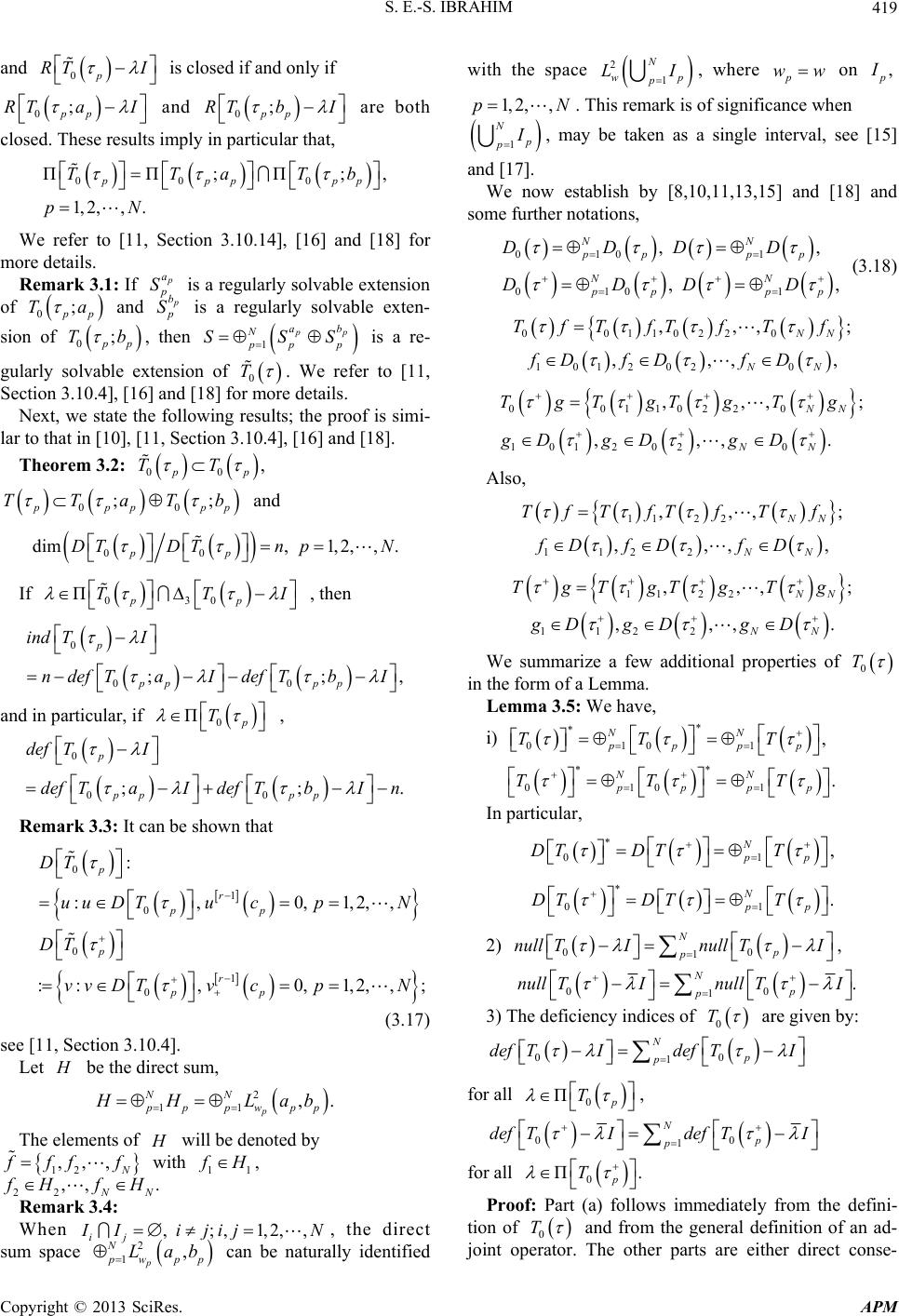 S. E.-S. IBRAHIM Copyright © 2013 SciRes. APM 419 and 0p RT I is closed if and only if 0; pp RT aI and 0; pp RT bI are both closed. These results imply in particular that, 00 0 ΠΠ;Π;, 1, 2,,. ppppp TTaTb pN We refer to [11, Section 3.10.14], [16] and [18] for more details. Remark 3.1: If a S is a regularly solvable extension of 0; p Ta and b S is a regularly solvable exten- sion of 0; p Tb , then 1 pp ab N pp p SSS is a re- gularly solvable extension of 0 T . We refer to [11, Section 3.10.4], [16] and [18] for more details. Next, we state the following results; the proof is simi- lar to that in [10], [11, Section 3.10.4], [16] and [18]. Theorem 3.2: 00 , pp TT 00 ;; pp pp TTaTb and 00 dim,1,2,, . pp DTDTnpN If 030 Πpp TTI , then 0 00 ;;, p pp pp indTI ndefTaI defTbI and in particular, if 0 Πp T , 0 00 ;;. p pp pp def TI def TaIdef TbIn Remark 3.3: It can be shown that 0 1 0 0 1 0 : :,0,1,2,, ::, 0,1,2,,; p r pp p r pp DT uu DTucpN DT vv DTvcpN (3.17) see [11, Section 3.10.4]. Let H be the direct sum, 2 11 ,. p NN pp pwpp HLab The elements of H will be denoted by 12 ,,, N ff f with 11 H, 22 ,, . N HfH Remark 3.4: When ,;,1,2,, ij Iijij N , the direct sum space 2 1, p N wpp ab can be naturally identified with the space 2 1 N wp p LI , where p ww on , 1, 2,,pN . This remark is of significance when 1 N p p , may be taken as a single interval, see [15] and [17]. We now establish by [8,10,11,13,15] and [18] and some further notations, 010 1 010 1 ,, ,, NN pp pp NN pp pp DDDD DDDD (3.18) 00110220 ,,, ; NN TfTfTfTf 101202 0 ,,, , NN fDfDf D 00110220 101202 0 ,,, ; ,,,. NN NN TgTgTgTg gDgDgD Also, 1122 ,,, ; NN TfT fTfTf 112 2 ,,, , NN fDfDf D 11 22 ,,, ; NN TgTgTgTg 112 2 ,,, . NN gDgDg D We summarize a few additional properties of 0 T in the form of a Lemma. Lemma 3.5: We have, i) 010 1 , NN pppp TTT 0101 . NN pp pp TTT In particular, 01 , N pp DT DTT 01 . N pp DTDTT 2) 00 1 N p p null TInull TI , 00 1. N p p nullTI nullTI 3) The deficiency indices of 0 T are given by: 00 1 N p p def TIdef TI for all 0 Πp T , 00 1 N p p def TIdef TI for all 0 Π. p T Proof: Part (a) follows immediately from the defini- tion of 0 T and from the general definition of an ad- joint operator. The other parts are either direct conse-  S. E.-S. IBRAHIM Copyright © 2013 SciRes. APM 420 quences of part (a) or follow immediately from the defi- nitions. Lemma 3.6: For 00 Π,TT , 00 def TIdef TI is constant and 00 02 .defTIdefTInN In the problem with one singular end-point, 00 2,nNdef TIdef TInN for all 00 Π,.TT In the regular problem, 00 2,def TIdef TInN for all 00 Π,.TT Proof: The proof is similar to that in [10, Lemma 2.4], [17] and [19] and therefore omitted. Lemma 3.7: Let 010 N p TT be a closed densely-defined operator on H. Then, 00 1 ΠN p p TT Proof: The proof follows from Lemma 3.5 and since 0 RT I is closed if and only if 0p RTI , 1, 2,, N are closed. Remark 3.8: If ,1,2,, p a p Sp N is a regularly solvable extension of 0; p Ta is a regularly solvable extension of b S then 0; p Tb is regularly solvable extension of 1 pp ab N pp p SSS . We refer to [10,11, 16] and [19] for more details. 4. The Product Operators The proof of general theorems will be based on the re- sults in this section. We start by listing some properties and results of quasi-differential expressions 12 ,,, n . For proofs the reader is referred to [3,8,10,17] and [19], and 121 21221 , fora complex nber. , um (4.1) A consequence of Properties (4.1) is that if then PP for P any polynomial with com- plex coefficients. Also we note that the leading coeffi- cients of a product are the product of the leading coeffi- cients. Hence the product of regular differential expres- sions is regular. Lemma 4.1: (cf. [19, Theorem 1]). Suppose j is a regular differential expression on the interval ,ab and 012 012 Π, nn TT , then we have, 1) The product operator 0 1 n jT is closed, den- sely-defined, and 00 1 1, nn jj j j defT I defTI 00 1 1– nn jj j j defTIdef TI . 2) 012 0 1 n nj j TT and 012 0 1. n nj j TT Note in part (ii) that the containment may be proper, i.e., the operators 012 n T and 0 1 n j jT are not equal in general. Lemma 4.2: Let 12 ,,, n be a regular differential expressions on ,ab and suppose that 012 012 Π, nn TT . Then 012 0 1 n nj j TT (4.2) if and only if the following partial separation conditions are satisfied: 1 2,, ,, s wloc fLabf ACab where s is the order of product expression 12 n and 12 n 2, w fLab together imply that: 2 1,,1,, 1 k jw jfLabk n . (4.3) Furthermore 012 0 1 n nj j TT and 012 0 1 n nj j TT if and only if , 012 0 1, n nj j def TIdef TI 012 0 1 n nj j def TIdef TI . We will say that the product 12 ,,, n is partially separated expressions in 2, w Lab whenever Property (4.3) holds. Lemma 4.3: For 012012 Π, nn TT we have, 012 012 00 11 Π, Π,. nn nn jj jj TT TT (4.4) Proof: Let 012 012 Π, nn TT , then from definition of the field of regularity we have 012 Πn T and 012 Π, n T i.e., each of the operators 012 n T and 012 n T has closed range and densely-defined on H with finite deficiency indices. Consequently by Lemma 4.2 each of the operators 0 1 n j jTI and 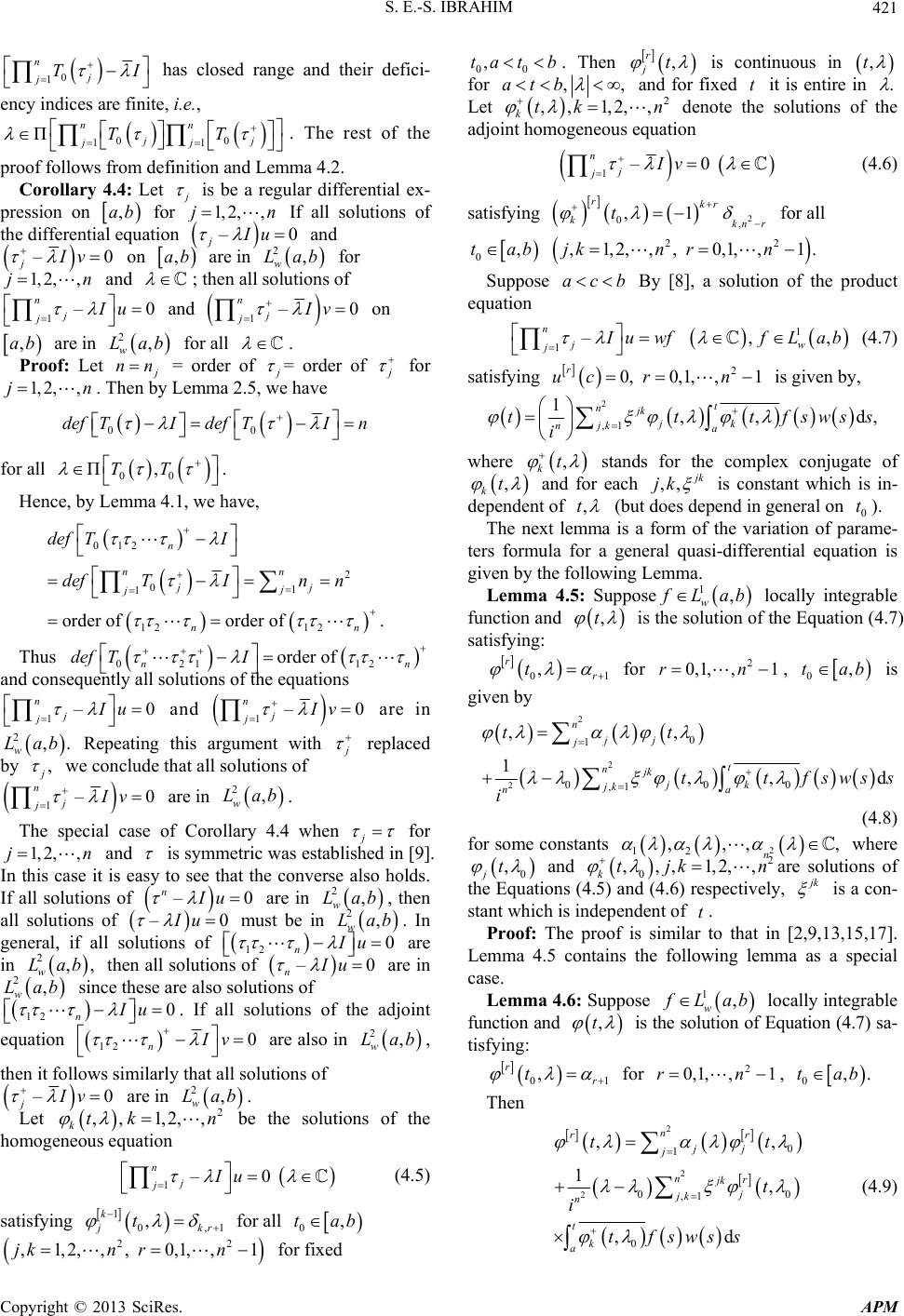 S. E.-S. IBRAHIM Copyright © 2013 SciRes. APM 421 0 1 n j jTI has closed range and their defici- ency indices are finite, i.e., 00 11 Πnn jj jj TT . The rest of the proof follows from definition and Lemma 4.2. Corollary 4.4: Let j is be a regular differential ex- pression on ,ab for 1, 2,, n If all solutions of the differential equation –0 jIu and –0 jIv on ,ab are in 2, w Lab for 1, 2,, n and ; then all solutions of 1–0 n j jIu and 1–0 n j jIv on ,ab are in 2, w Lab for all . Proof: Let j nn = order of j = order of for 1, 2,, n. Then by Lemma 2.5, we have 00 defTI defTI n for all 00 Π,TT . Hence, by Lemma 4.1, we have, 012 2 01 1 12 12 order oforde of.r n nn jj j j nn def TI defTIn n Thus 021 12 order of nn def TI and consequently all solutions of the equations 1–0 n j jIu and 1–0 n j jIv are in 2,. w Lab Repeating this argument with replaced by , j we conclude that all solutions of 1–0 n j jIv are in 2, w Lab . The special case of Corollary 4.4 when j for 1, 2,, n and is symmetric was established in [9]. In this case it is easy to see that the converse also holds. If all solutions of –0 nIu are in 2, w Lab , then all solutions of –0Iu must be in 2, w Lab . In general, if all solutions of 12 0 nIu are in 2,, w Lab then all solutions of –0 nIu are in 2, w Lab since these are also solutions of 12 0 nIu . If all solutions of the adjoint equation 12 0 nIv are also in 2, w Lab , then it follows similarly that all solutions of –0 jIv are in 2, w Lab . Let 2 ,, 1,2,, ktk n be the solutions of the homogeneous equation 1–0 n j jIu (4.5) satisfying 1 0,1 , k kr t for all 0,tab 22 ,1,2,,, 0,1,, 1jkn rn for fixed 00 ,ta tb . Then , r jt is continuous in ,t for ,,atb and for fixed t it is entire in . Let 2 ,, 1,2,, ktk n denote the solutions of the adjoint homogeneous equation 1–0 n j jIv (4.6) satisfying 2 0, ,1 rkr kkn r t for all 22 0,,1, 2,,,0,1,,1.tabjknr n Suppose acb By [8], a solution of the product equation 1 1–,, n jw j uwf fLab (4.7) satisfying 2 0,0,1, ,1 r uc rn is given by, 2 ,1 1,,d, t njk jk njk a tttfswss i where , kt stands for the complex conjugate of , kt and for each ,, k jk is constant which is in- dependent of ,t (but does depend in general on 0 t). The next lemma is a form of the variation of parame- ters formula for a general quasi-differential equation is given by the following Lemma. Lemma 4.5: Suppose 1, w Lab locally integrable function and ,t is the solution of the Equation (4.7) satisfying: 01 , rr t for 2 0,1, ,1rn , 0,tab is given by 2 2 2 0 1 000 ,1 ,, 1,, d n jj j t njk jk jk a n tt ttfswss i (4.8) for some constants 2 12 ,,,, n where 0 , jt and 2 0 ,,,1,2,, ktjk n are solutions of the Equations (4.5) and (4.6) respectively, k is a con- stant which is independent of t. Proof: The proof is similar to that in [2,9,13,15,17]. Lemma 4.5 contains the following lemma as a special case. Lemma 4.6: Suppose 1, w Lab locally integrable function and ,t is the solution of Equation (4.7) sa- tisfying: 01 , rr t for 2 0,1, ,1rn , 0,.tab Then 2 2 2 0 1 00 ,1 0 ,, 1, ,d n rr jj j nr jk j jk n t k a tt t i tfswss (4.9)  S. E.-S. IBRAHIM Copyright © 2013 SciRes. APM 422 for 2 1, ,1rn. We refer to [20] for more details. Lemma 4.7: Suppose that for some 0 all solu- tions of the equations 00 11 0, 0 nn jj jj II (4.10) are in 2,. w Lab Then all solutions of the equations in (4.10) are in 2, w Lab for every complex number . Proof: The proof is similar to that in [17, Theorem 5.3]. Lemma 4.8: Suppose that for some complex number 0 all solutions of the equations in (4.10) are in 2,. w Lab Suppose 2,. w Lab Then all solutions of the equation (4.7) are in 2, w Lab for all . Proof: The proof is similar to that in [19, Lemma 3.8]. Remark 4.9: Lemma 4.8 also holds if the function is bounded on ,ab . Lemma 4.10: Let 2, w Lab. Suppose for some 0 that: 1) All solutions of 1–0 n j jI are in 2, w Lab . 2) 2 0 ,,1,, r jtjn are bounded on ,ab for some 2 1, ,1rn. Then 2 ,, rw tLab for any solution ,t of the equation 1– n j j wf for all . Lemma 4.11: Suppose that for some complex 0 all solutions of the equation 1–0 n j jIv are in 2,, w Lac where acb. Suppose 2,, w Lab then 0 ,d, t k atfswss 2 1, 2,,jn is conti- nuous in ,t for atb and for all . Proof: It follows from Lemma 4.8; see [18, Lemma 3.6]. Lemma 4.12: The point spectra 0 1 n pj jT and 0 1 n pj jT of the product operators 0 1 n jT and 0 1 n jT are empty. Proof: See [17, Theorem 4.6]. Lemma 4.13: If ,, ab with ab then for any , the operator 0 1 n jT has closed range, zero nullity and deficiency 2 n . Hence, 0 1 1,2, 3 4,5 n ek j j k Tk (4.11) Proof: The proof is similar to that in [11, Lemma IX.9.11]; see [17, Lemma 4.9]. 5. The Product Operators in Direct Sum Spaces Next, we consider our interval is , ab and denote by 012 n T and 12 n T the minimal and maximal operators. We see from (3.15) and Lemma 4.2 that 01212 012nnn TT T and hence 012 n T and 012 n T form an adjoint pair of closed densely defined operators in 2, w Lab . From Lemmas 3.5 and 4.1 we have the fol- lowing: Lemma 5.1: For 00 11 Π, nn jj jj TT we have: 1) 010 11 nn N jp jp jj TT 11, n N pjp jT 010 11 11. nn N jp jp jj n N pjp j TT T 2) 0 1 n j j null TI 0 11 0 11 1 n N jp pj n Nn jr pj j null TI null TI 0 1 0 11 0 11 1 n j j n N jp pj n Nn jp pj j null TI null TI null TI 3) The deficiency indices of 0 1 n jT and 0 1 n jT are given by: 00 1 11 0 11 1, nn N jjp p jj n Nn jp pj j def TIdef TI def TI 00 1 11 0 11 1. nn N jjp p jj n Nn jp pj j def TIdef TI def TI Lemma 5.2: For 00 11 Π, nn jj jj TT , 00 11 nn jj jj def TIdef TI is constant and 0 1 2 0 1 0 2. n j j n j j def TI defTIn N In the problem with one singular end-point, 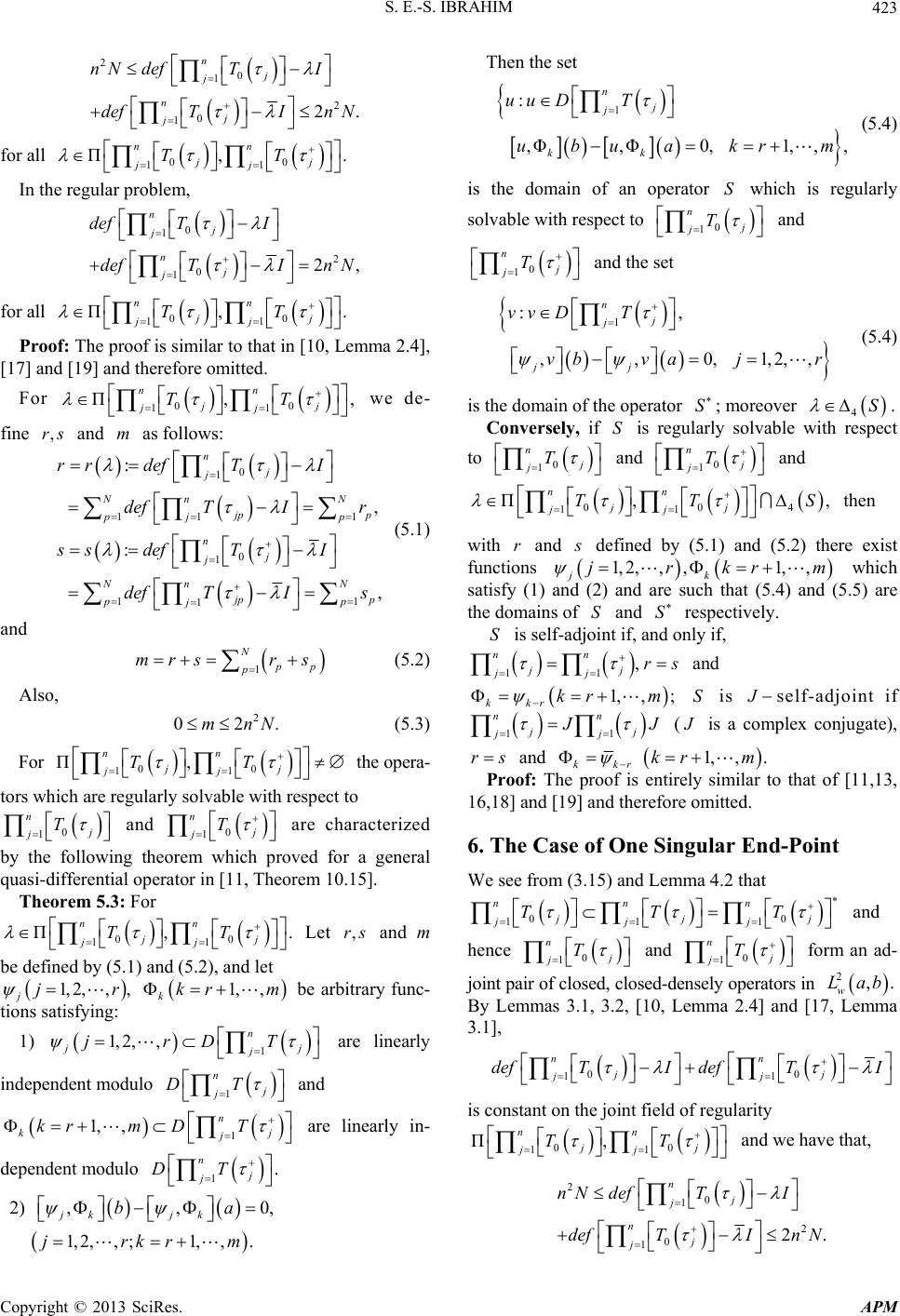 S. E.-S. IBRAHIM Copyright © 2013 SciRes. APM 423 2 0 1 2 0 12. n j j n j j nN defTI defTIn N for all 00 11 Π,. nn jj jj TT In the regular problem, 0 1 2 0 12, n j j n j j def TI defTIn N for all 00 11 Π,. nn jj jj TT Proof: The proof is similar to that in [10, Lemma 2.4], [17] and [19] and therefore omitted. For 00 11 Π,, nn jj jj TT we de- fine ,rs and m as follows: 0 1 11 1 0 1 11 1 : , : , n j j n NN pp pp j n j j n NN pp pp j rr defTI def TIr ss defTI def TIs (5.1) and 1 N pp p mrsr s (5.2) Also, 2 02.mnN (5.3) For 00 11 Π, nn jj jj TT the opera- tors which are regularly solvable with respect to 0 1 n j jT and 0 1 n j jT are characterized by the following theorem which proved for a general quasi-differential operator in [11, Theorem 10.15]. Theorem 5.3: For 00 11 Π,. nn jj jj TT Let ,rs and m be defined by (5.1) and (5.2), and let 1, 2,, jjr , 1, , kkr m be arbitrary func- tions satisfying: 1) 1 1, 2,,n jj j jrDT are linearly independent modulo 1 n j j DT and 1 1, ,n kj j krm DT are linearly in- dependent modulo 1. n j j DT 2) ,,0, jk jk ba 1,2, ,;1,,.jrkrm Then the set 1 : ,Φ,Φ0,1, ,, n j j kk uu DT ubuakrm (5.4) is the domain of an operator S which is regularly solvable with respect to 0 1 n j jT and 0 1 n j jT and the set 1 :, ,,0,1,2,, n j j jj vv DT vb vajr (5.4) is the domain of the operator S; moreover 4S . Conversely, if S is regularly solvable with respect to 0 1 n j jT and 0 1 n j jT and 004 11 Π,, nn jj jj TT S then with r and defined by (5.1) and (5.2) there exist functions 1, 2,,,1,, jk jrkrm which satisfy (1) and (2) and are such that (5.4) and (5.5) are the domains of S and S respectively. S is self-adjoint if, and only if, 11 , nn jj jj rs and 1, ,; kkr kr m S is self-adjoint if 11 nn jj jj J ( is a complex conjugate), rs and 1, ,. kkr kr m Proof: The proof is entirely similar to that of [11,13, 16,18] and [19] and therefore omitted. 6. The Case of One Singular End-Point We see from (3.15) and Lemma 4.2 that 00 111 nnn jjj jjj TTT and hence 0 1 n j jT and 0 1 n j jT form an ad- joint pair of closed, closed-densely operators in 2,. w Lab By Lemmas 3.1, 3.2, [10, Lemma 2.4] and [17, Lemma 3.1], 00 11 nn jj jj def TIdef TI is constant on the joint field of regularity 00 11 Π, nn jj jj TT and we have that, 2 0 1 2 0 12. n j j n j j nN defTI defTIn N 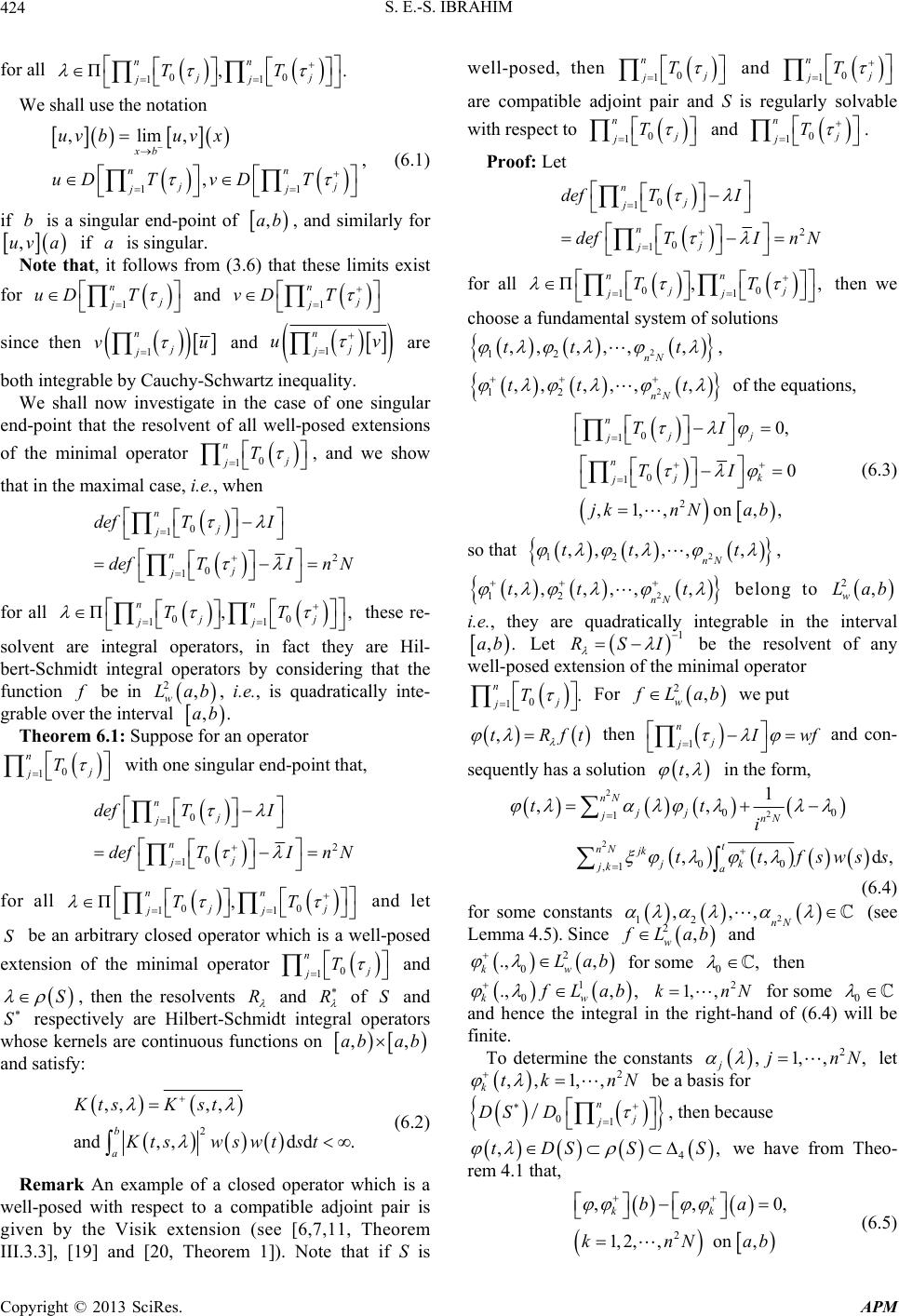 S. E.-S. IBRAHIM Copyright © 2013 SciRes. APM 424 for all 00 11 Π,. nn jj jj TT We shall use the notation 11 ,lim, , xb nn jj jj uv buvx uD T vDT , (6.1) if b is a singular end-point of ,ab , and similarly for ,uva if a is singular. Note that, it follows from (3.6) that these limits exist for 1 n j j uDT and 1 n j j vD T since then 1 n j j vu and 1 n j j uv are both integrable by Cauchy-Schwartz inequality. We shall now investigate in the case of one singular end-point that the resolvent of all well-posed extensions of the minimal operator 0 1 n j jT , and we show that in the maximal case, i.e., when 0 1 2 0 1 n j j n j j def TI defTIn N for all 00 11 Π,, nn jj jj TT these re- solvent are integral operators, in fact they are Hil- bert-Schmidt integral operators by considering that the function be in 2, w Lab , i.e., is quadratically inte- grable over the interval ,.ab Theorem 6.1: Suppose for an operator 0 1 n j jT with one singular end-point that, 0 1 2 0 1 n j j n j j def TI defTIn N for all 00 11 Π, nn jj jj TT and let S be an arbitrary closed operator which is a well-posed extension of the minimal operator 0 1 n j jT and S , then the resolvents R and R of S and S respectively are Hilbert-Schmidt integral operators whose kernels are continuous functions on ,,abab and satisfy: 2 ,, ,, and,,d d. b a KtsK st Ktswswt st (6.2) Remark An example of a closed operator which is a well-posed with respect to a compatible adjoint pair is given by the Visik extension (see [6,7,11, Theorem III.3.3], [19] and [20, Theorem 1]). Note that if S is well-posed, then 0 1 n j jT and 0 1 n j jT are compatible adjoint pair and S is regularly solvable with respect to 0 1 n j jT and 0 1 n j jT . Proof: Let 0 1 2 0 1 n j j n j j def TI defTIn N for all 00 11 Π,, nn jj jj TT then we choose a fundamental system of solutions 2 12 ,, ,,,, nN tt t , 2 12 ,, ,,,, nN tt t of the equations, 0 1 0 1 2 0, 0 ,1,, on,, n jj j n jk j TI TI jknN ab (6.3) so that 2 12 ,, ,,,, nN tt t , 2 12 ,, ,,,, nN tt t belong to 2, w Lab i.e., they are quadratically integrable in the interval ,.ab Let 1 RSI be the resolvent of any well-posed extension of the minimal operator 0 1. n j jT For 2, w Lab we put ,tRft then 1 n j j wf and con- sequently has a solution ,t in the form, 2 2 2 00 1 00 ,1 1 ,, ,, d, nN jj jnN t nN jk jk jk a tt i ttfswss (6.4) for some constants 2 12 ,,, nN (see Lemma 4.5). Since 2, w Lab and 2 0 ., , kw Lab for some 0, then 1 0 .,, , kw Lab 2 1, ,knN for some 0 and hence the integral in the right-hand of (6.4) will be finite. To determine the constants 2 ,1,, , jjnN let 2 ,, 1,, ktknN be a basis for 01 n j j DS D /, then because 4 ,,tDSSS we have from Theo- rem 4.1 that, 2 ,,0, 1, 2,,,on kk ba knNab (6.5)  S. E.-S. IBRAHIM Copyright © 2013 SciRes. APM 425 and hence from (6.4), (6.5) and on using Lemma 4.6, we have: 22 2 2 00 1,1 2 1 1 ,,d,, ,,,1,2,,. t nNnN jk kjk jk jjk a nN nN kjjk j btfswssb i aaknN (6.6) By substituting these expressions into the conditions (6.5), we get: 22 2 2 00 1,1 1 1,d, ,. t nNnN jk jkjk jjk a nN nN jjk j tfswssb i a This implies that the system 22 2 0 0 1,1 ,,d, bt nNnN jk jjk k jjk a anN tfswss i (6.7) in the variable 2 ,1,2,,. jjnN The determinant of this system does not vanish (see [16, Theorem 3.27] and [19]). If we solve the system (6.7) we obtain: 2 2 02 ,1 ,d,1,2,,. b nN jk jj jk a nN hsfswss jnN i (6.8) where , j hs is a solution of the system: 22 0 1,1 ,, ,,. b nNnN jk jjk kjk jjk a hst b (6.9) Since, the determinant of the above system (6.9) does not vanish, and the functions 0 ,, ks 2 1, 2,,knN are continuous in the interval ,ab , then the functions , j hs are also continuous in the interval. By substituting in formula (6.4) for the expres- sions 2 ,1,2,, jjnN we get, 2 2 2 0 0 ,1 0 0 1 () ,, ,, d ,, d nN jj jk nN tjkkj a b nN jj jt Rft tt i thsfswss thsfswss (6.10) Now, we put 2 2 2 2 0 0 1 0 00 ,1 ,, ,, for ,, , for , nN jj j nN nN jkjkj jk nN Kts ths its tths its (6.11) Formula (6.10) then takes the form for all ,, d ,, b a RftKtsf swss tab (6.12) i.e.,R is an integral operator with the kernel ,, st operating on the functions 2,. w Lab Similarly, the solutions ,t of the equation 1 n j j wg has the form: 2 2 2 0 1 0 00 ,1 , , ,, d, nN jj j s nN jk jk jk a nN s s tgtwtt i (6.13) where 0 , kt and 2 0 ,,, 1,2,, j kj nN are solutions of the equations in (6.6). The argument as be- fore leads to, 2 ,,do, ,fr b w a RgtKstgtwt tgLab (6.14) i.e.,R is an integral operator with the kernel ,,Kst operating on the functions 2, w Lab where, 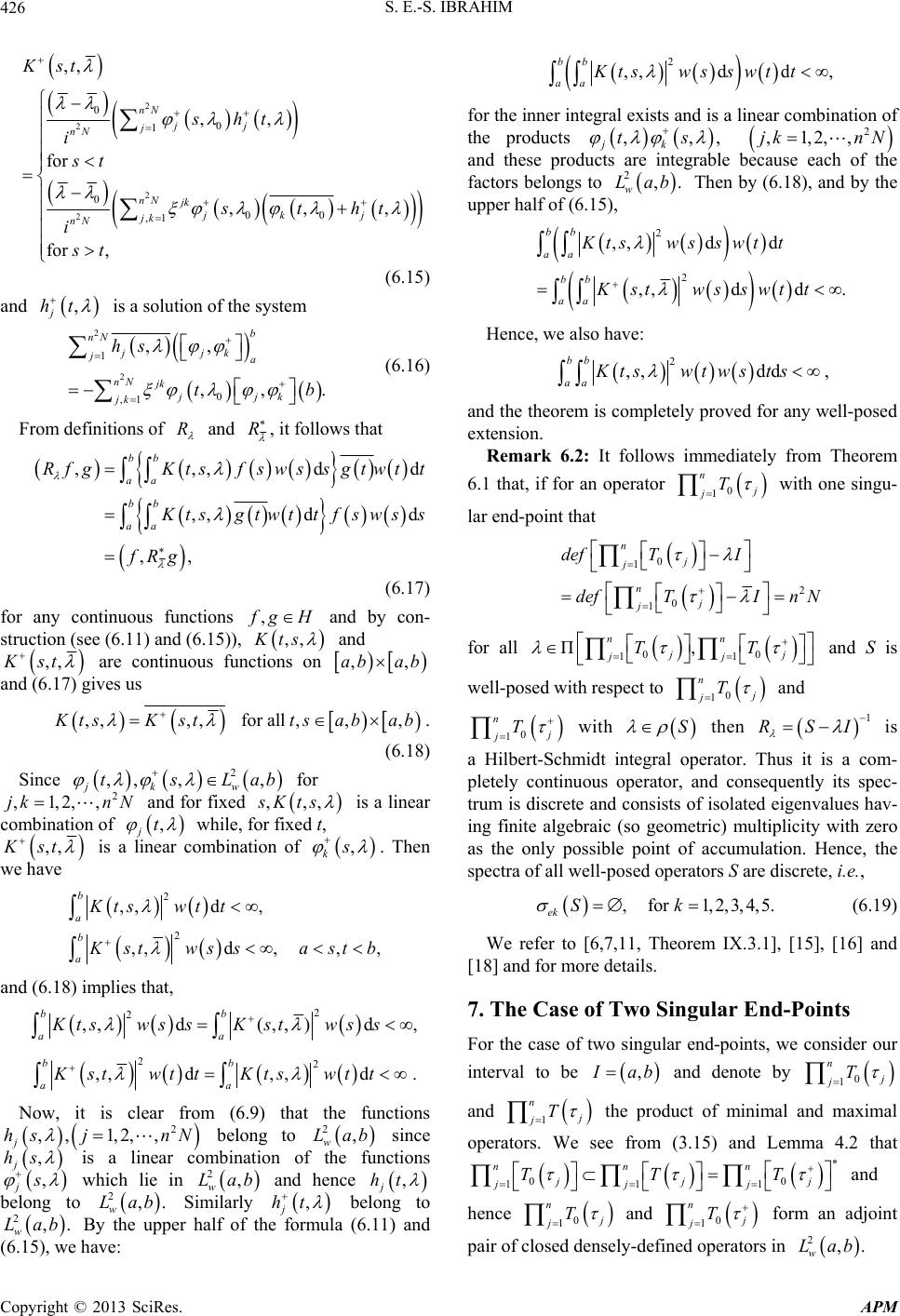 S. E.-S. IBRAHIM Copyright © 2013 SciRes. APM 426 2 2 2 2 0 0 1 0 00 ,1 ,, ,, for ,, , for , nN jj j nN nN jkjk j jk nN Kst sht ist stht ist (6.15) and , j ht is a solution of the system 2 2 1 0 ,1 ,, ,,. b nN jjk ja nN jkjjk jk hs tb (6.16) From definitions of R and R , it follows that ,,,dd ,, dd ,, bb aa bb aa RfgKtsf swssgtwtt tsgtwtt fswss fRg (6.17) for any continuous functions , gH and by con- struction (see (6.11) and (6.15)), ,,Kts and ,,Kst are continuous functions on ,,abab and (6.17) gives us for a,, ll,,,,,K tsKsttsabab . (6.18) Since 2 ,, ,, jk w tsLab for 2 ,1,2,,jk nN and for fixed ,,,sKt s is a linear combination of , jt while, for fixed t, ,,Kst is a linear combination of , k . Then we have 2 2 ,,d , ,,d,,, b a b a Ktswt t Kst wssastb and (6.18) implies that, 2 2 ,,d(,, )d, bb aa KtswssK stwss 22 ,,d,,d . bb aa KstwttKts wtt Now, it is clear from (6.9) that the functions 2 ,, 1,2,, j hs jnN belong to 2, w Lab since , j hs is a linear combination of the functions , j which lie in 2, w Lab and hence , j ht belong to 2,. w Lab Similarly , j ht belong to 2,. w Lab By the upper half of the formula (6.11) and (6.15), we have: 2 ,,dd , bb aa Ktsws swtt for the inner integral exists and is a linear combination of the products ,,, jk ts 2 ,1,2,,jk nN and these products are integrable because each of the factors belongs to 2,. w Lab Then by (6.18), and by the upper half of (6.15), 2 2 ,,d d ,,dd . bb aa bb aa Ktsws swt t Kst wsswtt Hence, we also have: 2 ,, dd bb aa Ktswtws ts , and the theorem is completely proved for any well-posed extension. Remark 6.2: It follows immediately from Theorem 6.1 that, if for an operator 0 1 n jT with one singu- lar end-point that 0 1 2 0 1 n j j n j j def TI defTIn N for all 00 11 Π, nn jj jj TT and S is well-posed with respect to 0 1 n jT and 0 1 n jT with S then 1 RSI is a Hilbert-Schmidt integral operator. Thus it is a com- pletely continuous operator, and consequently its spec- trum is discrete and consists of isolated eigenvalues hav- ing finite algebraic (so geometric) multiplicity with zero as the only possible point of accumulation. Hence, the spectra of all well-posed operators S are discrete, i.e., for, 1,2,3,4,5. ek Sk (6.19) We refer to [6,7,11, Theorem IX.3.1], [15], [16] and [18] and for more details. 7. The Case of Two Singular End-Points For the case of two singular end-points, we consider our interval to be , ab and denote by 0 1 n jT and 1 n jT the product of minimal and maximal operators. We see from (3.15) and Lemma 4.2 that 00 111 nnn jjj jjj TTT and hence 0 1 n jT and 0 1 n jT form an adjoint pair of closed densely-defined operators in 2,. w Lab 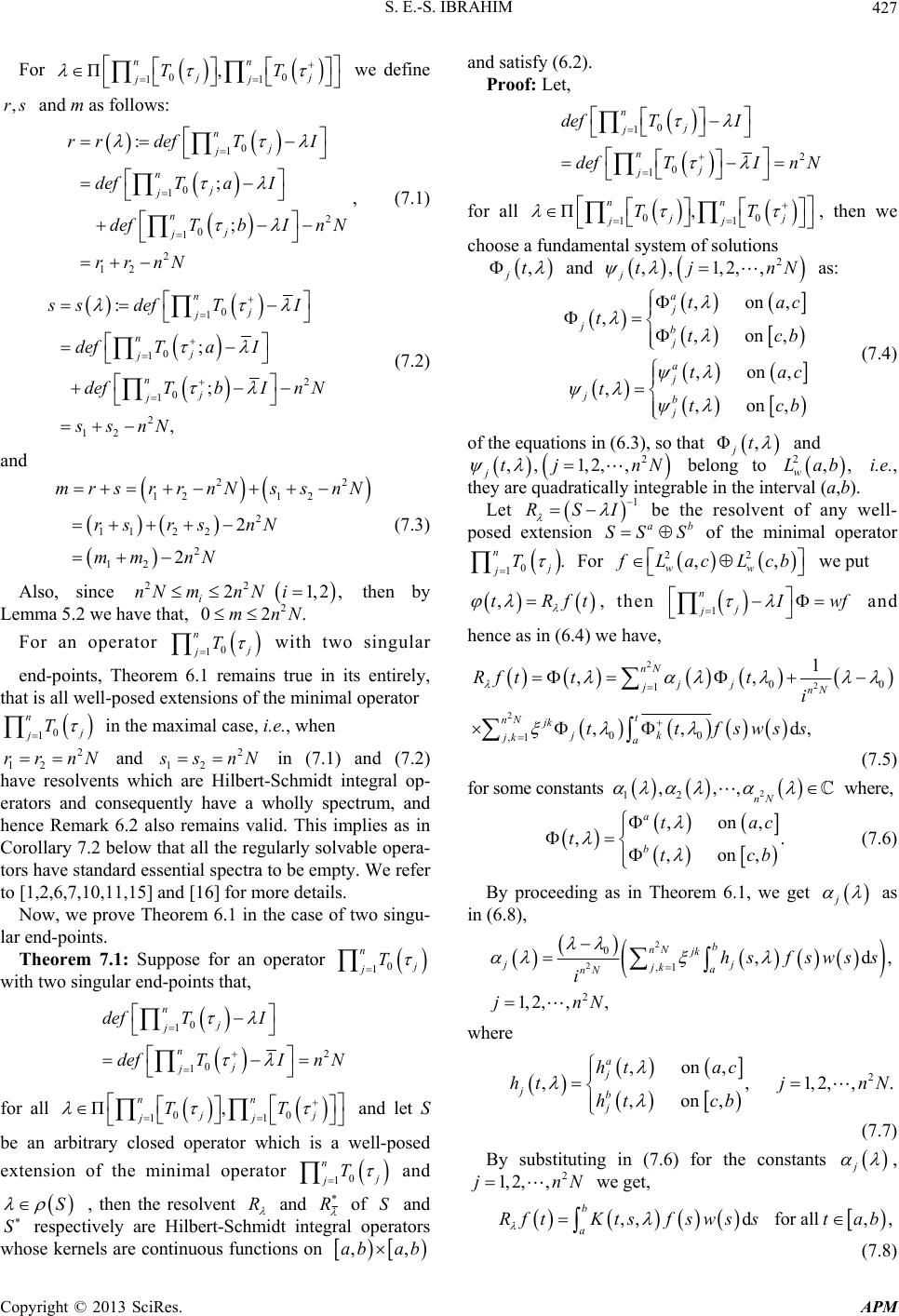 S. E.-S. IBRAHIM Copyright © 2013 SciRes. APM 427 For 00 11 Π, nn jj jj TT we define ,rs and m as follows: 0 1 0 1 2 0 1 2 12 : ; ; n j j n j j n j j rr defTI defTa I defTbIn N rrnN , (7.1) 0 1 0 1 2 0 1 2 12 : ; ; , n j j n j j n j j sdef TI defTaI defTbInN ssnN (7.2) and 22 121 2 2 1122 2 12 2 2 mrsrrnNs snN rs rsnN mm nN (7.3) Also, since 22 21,2, i nNmnNi then by Lemma 5.2 we have that, 2 02.mnN For an operator 0 1 n jT with two singular end-points, Theorem 6.1 remains true in its entirely, that is all well-posed extensions of the minimal operator 0 1 n jT in the maximal case, i.e., when 2 12 rrnN and 2 12 snN in (7.1) and (7.2) have resolvents which are Hilbert-Schmidt integral op- erators and consequently have a wholly spectrum, and hence Remark 6.2 also remains valid. This implies as in Corollary 7.2 below that all the regularly solvable opera- tors have standard essential spectra to be empty. We refer to [1,2,6,7,10,11,15] and [16] for more details. Now, we prove Theorem 6.1 in the case of two singu- lar end-points. Theorem 7.1: Suppose for an operator 0 1 n jT with two singular end-points that, 0 1 2 0 1 n j j n j j def TI defTIn N for all 00 11 Π, nn jj jj TT and let S be an arbitrary closed operator which is a well-posed extension of the minimal operator 0 1 n jT and S , then the resolvent R and R of S and S respectively are Hilbert-Schmidt integral operators whose kernels are continuous functions on ,,abab and satisfy (6.2). Proof: Let, 0 1 2 0 1 n j j n j j def TI defTIn N for all 00 11 Π, nn jj jj TT , then we choose a fundamental system of solutions , jt and 2 ,, 1,2,, jtjnN as: ,on, ,,on, ,on, ,,on, a j jb j a j jb j tac ttcb tac ttcb (7.4) of the equations in (6.3), so that Φ, jt and 2 ,, 1,2,, jtjnN belong to 2,, w Lab i.e., they are quadratically integrable in the interval (a,b). Let 1 RSI be the resolvent of any well- posed extension ab SS S of the minimal operator 0 1. n jT For 22 ,, ww Lac Lcb we put ,tRft , then 1 n j j wf and hence as in (6.4) we have, 2 2 2 00 1 00 ,1 1 ,, ,, d, nN jj jnN t nN jkjk jk a Rfttt i ttfswss (7.5) for some constants 2 12 ,,, nN where, ,on, ,. ,on, a b tac ttcb (7.6) By proceeding as in Theorem 6.1, we get j as in (6.8), 2 2 0 ,1 2 ,d, 1, 2,,, b nN jk jj jk a nN hs fswss i jnN where 2 ,on, ,,1,2,,. ,on, a j jb j ht ac htj nN ht cb (7.7) By substituting in (7.6) for the constants j , 2 1, 2,,jnN we get, for all,,d, , b a RftKtsf swsstab (7.8)  S. E.-S. IBRAHIM Copyright © 2013 SciRes. APM 428 ,,on , ,, , ,,on , a b ts ac Kts ts cb (7.9) and .,,Kts can be obtained as in (6.11). Similarly, 2 (,, )d,fo ,r b w a RgtK stgsws sgLab (7.10) ,,on , ,, ,,on , a b st ac Kst st cb From (6.11) and (6.15) we have that 2 2 ,,d, (,,)d,,, b a b a Ktswt t stws sastb and (6.18) implies that, 2 2 ,,d,,d , bb aa Kts wss Kstwss 22 (,, )d,,d. bb aa Kst wtt Ktswtt The rest of the proof is entirely similar to the corre- sponding part of the proof of Theorem 6.1. We refer to [1, 5,6,7,15,16] and [18] for more details. Corolla ry 7. 2: Let 00 11 Π, nn jj jj TT with 0 1 2 0 1. n j j n j j def TI defTIn N (7.11) Then, for,1,2,3. ek Sk (7.12) of all regularly solvable extensions S with respect to the compatible adjoint pair 0 1 n jT and 0 1. n jT Proof: Since 0 1 2 0 1, n j j n j j def TI defTIn N for all 00 11 Π, nn jj jj TT . Then we have from [15, Theorem III.3.5] that, 00 1 2 0 1 dim , n j j n j j DS DT defTIn N / 00 1 2 0 1 dim . n j j n j j DS DT defTIn N / Thus S is an 2dimensi al-onnN extension of 0 1 n jT and so by [11, Corollary IX.4.2], 0 1,1,2,3. n ek ekj j STk (7.13) From Lemmas 4.12 and 4.13, we get, 0 1,1,2,3. n ek j jTk (7.14) Hence, by (7.14) we have that, ,1,2,3. ek Sk Remark 7.3: If S is well-posed (say the Visik exten- sion, see [20]) we get from (6.19) and (7.13) that 0 1,1,2,3. n ek j jTk On applying (7.13) again to any regularly solvable ex- tensions S under consideration, hence (7.12). Corollary 7.4: If for some 0, there are 2 nN linearly independent solutions of the equations 00 11 0, 0 nn jj jj wu wv (7.15) in 2, w Lab , 000 11 Π, nn jj jj TT and hence, 00 11 Π, nn jj jj TT and 00 11 ,, nn ek jj jj TT 1, 2, 3,k where 00 11 , nn ek jj jj TT is the joint es- sential spectra of 0 1, n jT 0 1 n jT defined as the joint field of regularity 00 11 Π, nn jj jj TT . Proof: Since all solutions of the equations in (7.15) are in 2, w Lab for some 0 in then, 00 1 2 00 1, n j j n j j def TI defTIn N for some 000 11 Π, nn jj jj TT . From Le- mma 3.10, we have that 0 1 n jT has no eigenval- ues and so 1 00 1 n j jTI exists and its domain 00 1 n j j RT I is a closed subspace of 2,. w Lab 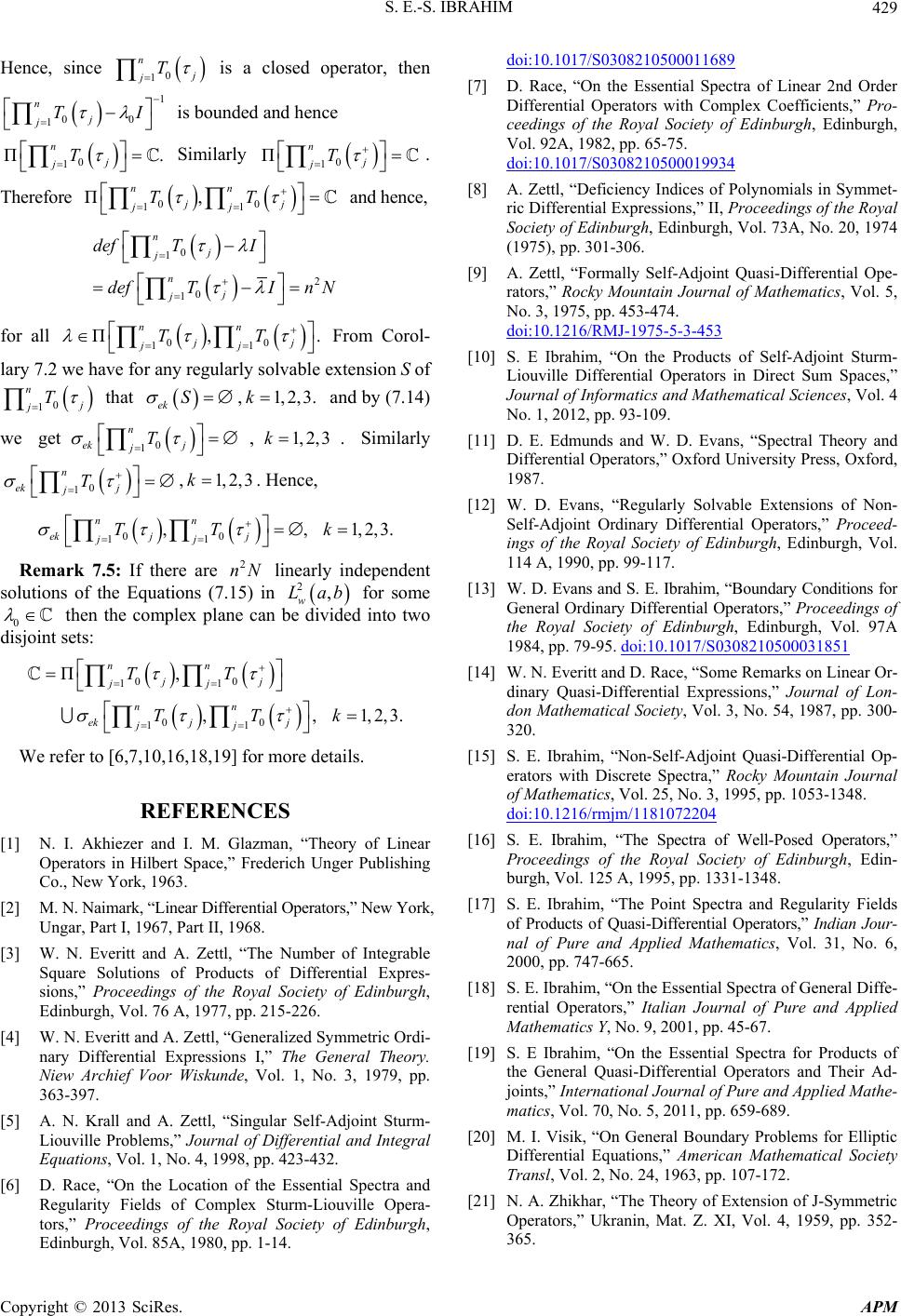 S. E.-S. IBRAHIM Copyright © 2013 SciRes. APM 429 Hence, since 0 1 n jT is a closed operator, then 1 00 1 n j jTI is bounded and hence 0 1 Π. n j jT Similarly 0 1 Πn j jT . Therefore 00 11 Π, nn jj jj TT and hence, 0 1 2 0 1 n j j n j j def TI defTIn N for all 00 11 Π,. nn jj jj TT From Corol- lary 7.2 we have for any regularly solvable extension S of 0 1 n jT that ek S ,1,2, 3.k and by (7.14) we get 0 1 n ek j jT ,1, 2, 3k. Similarly 0 1 n ek j jT ,1, 2, 3k. Hence, 00 11 ,,1,2,3. nn ek jj jj TTk Remark 7.5: If there are 2 nN linearly independent solutions of the Equations (7.15) in 2, w Lab for some 0 then the complex plane can be divided into two disjoint sets: 00 11 00 11 Π, ,,1,2,3. nn jj jj nn ek jj jj TT TTk We refer to [6,7,10,16,18,19] for more details. REFERENCES [1] N. I. Akhiezer and I. M. Glazman, “Theory of Linear Operators in Hilbert Space,” Frederich Unger Publishing Co., New York, 1963. [2] M. N. Naimark, “Linear Differential Operators,” New York, Ungar, Part I, 1967, Part II, 1968. [3] W. N. Everitt and A. Zettl, “The Number of Integrable Square Solutions of Products of Differential Expres- sions,” Proceedings of the Royal Society of Edinburgh, Edinburgh, Vol. 76 A, 1977, pp. 215-226. [4] W. N. Everitt and A. Zettl, “Generalized Symmetric Ordi- nary Differential Expressions I,” The General Theory. Niew Archief Voor Wiskunde, Vol. 1, No. 3, 1979, pp. 363-397. [5] A. N. Krall and A. Zettl, “Singular Self-Adjoint Sturm- Liouville Problems,” Journal of Differential and Integral Equations, Vol. 1, No. 4, 1998, pp. 423-432. [6] D. Race, “On the Location of the Essential Spectra and Regularity Fields of Complex Sturm-Liouville Opera- tors,” Proceedings of the Royal Society of Edinburgh, Edinburgh, Vol. 85A, 1980, pp. 1-14. doi:10.1017/S0308210500011689 [7] D. Race, “On the Essential Spectra of Linear 2nd Order Differential Operators with Complex Coefficients,” Pro- ceedings of the Royal Society of Edinburgh, Edinburgh, Vol. 92A, 1982, pp. 65-75. doi:10.1017/S0308210500019934 [8] A. Zettl, “Deficiency Indices of Polynomials in Symmet- ric Differential Expressions,” II, Proceedings of the Royal Society of Edinburgh, Edinburgh, Vol. 73A, No. 20, 1974 (1975), pp. 301-306. [9] A. Zettl, “Formally Self-Adjoint Quasi-Differential Ope- rators,” Rocky Mountain Journal of Mathematics, Vol. 5, No. 3, 1975, pp. 453-474. doi:10.1216/RMJ-1975-5-3-453 [10] S. E Ibrahim, “On the Products of Self-Adjoint Sturm- Liouville Differential Operators in Direct Sum Spaces,” Journal of Informatics and Mathematical Sciences, Vol. 4 No. 1, 2012, pp. 93-109. [11] D. E. Edmunds and W. D. Evans, “Spectral Theory and Differential Operators,” Oxford University Press, Oxford, 1987. [12] W. D. Evans, “Regularly Solvable Extensions of Non- Self-Adjoint Ordinary Differential Operators,” Proceed- ings of the Royal Society of Edinburgh, Edinburgh, Vol. 114 A, 1990, pp. 99-117. [13] W. D. Evans and S. E. Ibrahim, “Boundary Conditions for General Ordinary Differential Operators,” Proceedings of the Royal Society of Edinburgh, Edinburgh, Vol. 97A 1984, pp. 79-95. doi:10.1017/S0308210500031851 [14] W. N. Everitt and D. Race, “Some Remarks on Linear Or- dinary Quasi-Differential Expressions,” Journal of Lon- don Mathematical Society, Vol. 3, No. 54, 1987, pp. 300- 320. [15] S. E. Ibrahim, “Non-Self-Adjoint Quasi-Differential Op- erators with Discrete Spectra,” Rocky Mountain Journal of Mathematics, Vol. 25, No. 3, 1995, pp. 1053-1348. doi:10.1216/rmjm/1181072204 [16] S. E. Ibrahim, “The Spectra of Well-Posed Operators,” Proceedings of the Royal Society of Edinburgh, Edin- burgh, Vol. 125 A, 1995, pp. 1331-1348. [17] S. E. Ibrahim, “The Point Spectra and Regularity Fields of Products of Quasi-Differential Operators,” Indian Jour- nal of Pure and Applied Mathematics, Vol. 31, No. 6, 2000, pp. 747-665. [18] S. E. Ibrahim, “On the Essential Spectra of General Diffe- rential Operators,” Italian Journal of Pure and Applied Mathematics Y, No. 9, 2001, pp. 45-67. [19] S. E Ibrahim, “On the Essential Spectra for Products of the General Quasi-Differential Operators and Their Ad- joints,” International Journal of Pure and Applied Mathe- matics, Vol. 70, No. 5, 2011, pp. 659-689. [20] M. I. Visik, “On General Boundary Problems for Elliptic Differential Equations,” American Mathematical Society Transl, Vol. 2, No. 24, 1963, pp. 107-172. [21] N. A. Zhikhar, “The Theory of Extension of J-Symmetric Operators,” Ukranin, Mat. Z. XI, Vol. 4, 1959, pp. 352- 365.
|